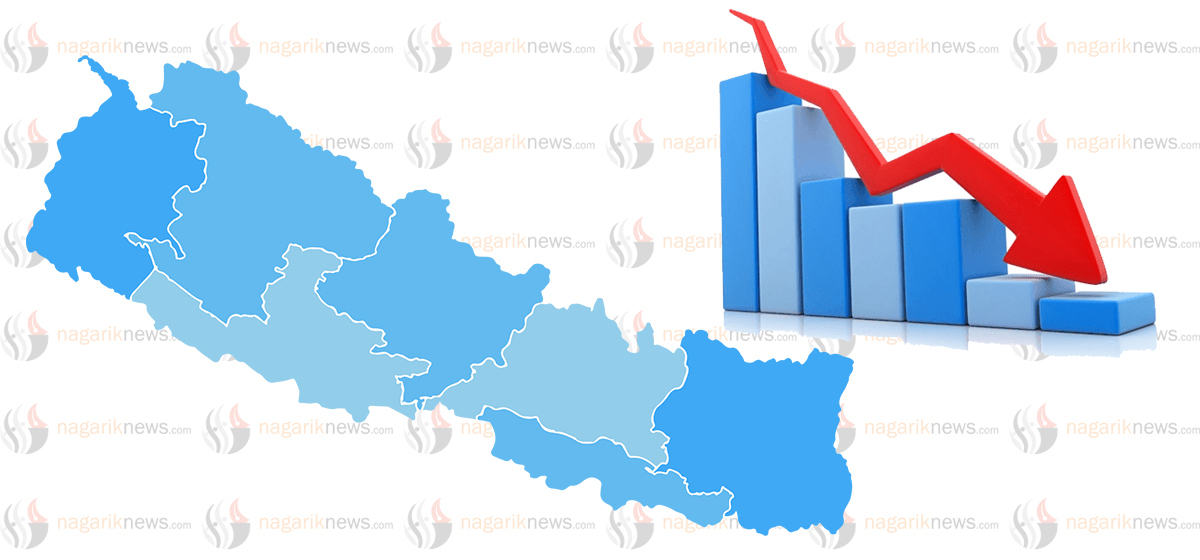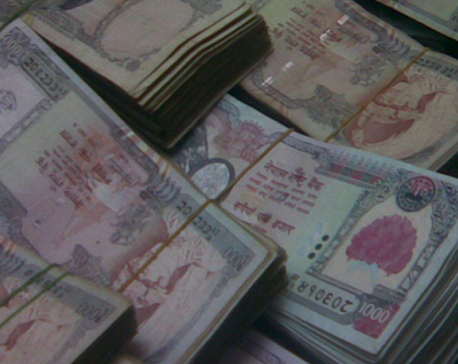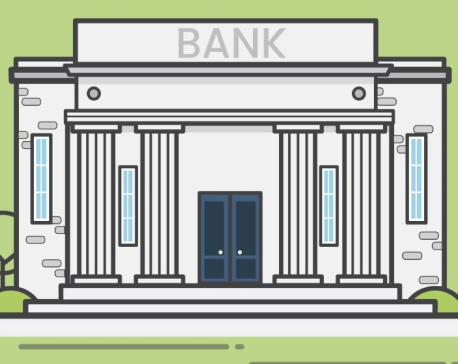
OR
Nepal’s banking sector faces impact of sluggish economy
Published On: January 28, 2024 06:48 PM NPT By: Dilip Paudel

KATHMANDU, Jan 28: The country's sluggish economy has affected the banks’ balance sheets. Due to the problems seen in the economy, industries and businesses have been affected, and industrialists and businessmen have not been able to pay the interest on their loans on time.
The number of industries and businesses blacklisted is also increasing. As banks are unable to collect loans and interest, bad loans continue to rise. Investors have not been able to get returns from the billions of rupees invested in the banking sector when the profits of the banks have decreased.
In the first six months of the current fiscal year 2023/24 till mid-January, the balance sheet of 20 commercial banks has been directly affected by the sluggish economy. Profits of commercial banks have decreased by 10 percent while bad loans have increased by 47 percent.
Prabal Jung Pandey, chairman of the Board of Directors of Citizens Bank International, said that the banking sector is facing economic problems. Pandey said, “Since there is no demand in the market, it has affected the business. After the business has been affected, industrialists and businessmen have not been able to pay the loan principal and interest.”
He said that even though they have been stating that if they reduce the interest rate, the problem of the sluggish economy will be improved, there has been no improvement yet. He said that due to low supply and demand, businessmen could not pay interest according to the loan size. In the last fiscal year, despite problems in other indicators of the economy, the banking sector was strong.
Even if the investors do not get returns due to the decrease in the bank's profits, the increase in bad loans is a matter of concern. It appears that the financial sector is in crisis. As the revenue of the banks is also affected when the profit of the banks is reduced, it has a direct impact on the state operations. If the government is unable to collect revenue as per the target, development works will be affected.
The net profit of most commercial banks has decreased due to the shrinking of the economic sector. Till mid-January of the current fiscal year, 20 commercial banks have made a net profit of Rs 28.68 billion. This is a decrease of about 8.44 percent compared to last fiscal year. The net profit of commercial banks of the last fiscal year during the same period was Rs 31.34 billion.
Dilliram Pokharel, the information officer of Nepal Rastra Bank (NRB), said that due to the slowdown in the economy, the bank's debt recovery has become difficult and the profit has also decreased. “Due to the slowdown in the economy, production, employment, imports, repayments have been affected,” he said.
In the first six months of the last fiscal year 2022/23 (up to mid-January), bad loans of 20 commercial banks were on average 2.22 percent, but in the same period of the current fiscal year, it has increased by 47 percent to 3.26 percent. The bank's bad loans have increased by 387.23 percent.
After the borrowers take a loan from the bank, if they fail to pay the loan within the stipulated time, banks categorize such loans as bad loans. The bad loans of Kumari Bank Limited have reached 4.97 percent.
SBI Bank's bad loans increased by 387.23 percent to 2.29 percent from 0.47 percent in the second quarter of last fiscal year. Not only SBI, but bad loans of all banks have increased.
If the loan provided to a borrower by a financial institution or bank for a certain period is not recovered on time, it is called a bad loan. It is also known as a 'Non-Performing Loan' (NPL) in banking parlance. Bad debt increases if the borrower fails to repay the loan within the stipulated time.
If the bank fails to collect the loan even after 90 days from the due date, the loan is classified as a bad loan. Bad debt has increased because industrialists and businessmen failed to pay the interest and principal of the loan to the bank within the stipulated time.
Laxmi Sunrise Bank's bad loans increased by nearly 200 percent to 4.67 percent. Bad loans are 4.9 percent for Prabhu Bank, 4.95 percent for Himalayan Bank, 4.75 for percent Nepal Investment Mega Bank, 4.68 for percent Global IME Bank, 4.5 percent for Nepal Bank, 4.07 percent for Prime Bank, 4.07 for Citizens Bank and 3.95 percent for Rastriya Banijya Bank (RBB). Bad loans from other banks are less than three percent. Only the Agriculture Development Bank, Siddhartha Bank, and Nabil Bank have low bad loans.
You May Like This

Commercial banks record interest income of Rs 64.76 billion in first four months of current FY
KATHMANDU, Dec 30: Commercial banks have earned Rs 64.76 billion interest in four months of the current fiscal year (mid-July... Read More...

Commercial banks introduce diverse interest rates for Bhadra month
KATHMANDU, Aug 17: In a significant departure from the recently abolished cartelization of interest rates by the Nepal Bankers' Association... Read More...

40 local units yet to have presence of bank
KATHMANDU, April 21: Commercial banks are yet to expand their reach to 40 local units as of mid-March. Though the... Read More...




Just In
- Sunkoshi-Marin Diversion Project’s tunnel construction nears completion, breakthrough scheduled for May 8
- Govt tightens security arrangement for Third Investment Summit 2024
- Pesticide residue found in vegetables in Nepalgunj
- Aam Janata Party and Samajwadi Jana Ekata Party merge
- 1,600 participants confirmed for Nepal Investment Summit
- Ilam-2 by-elections held peacefully, vote count likely to start tonight
- NEA schedules five-day power cut across Kathmandu Valley for underground cable installation
- Hundreds of passengers including foreign tourists in distress as poor visibility halts flights to and from PRIA







-1200x560-wm_20240427144118.jpg)





Leave A Comment